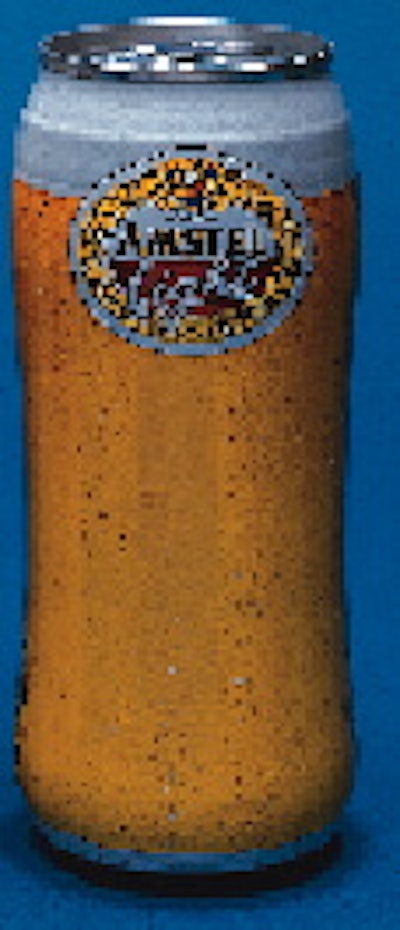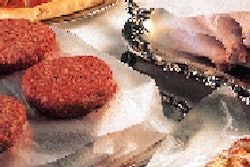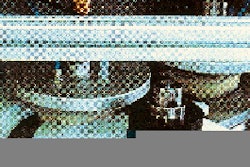
But none more visible. The new packaging silhouettes we're encountering for some familiar names underscore one of the primary objectives of commercial packaging: drawing attention to, and selling, product. Beverage packaging's newest profiles may also be early indicators of shapes to come in other product categories. Recent beverage packaging introductions are helping some recognizable brand names stand out as individual trees in a forest of familiar competitors. Consider: "Beer-glass" cans for Heineken. While Coke was making a media splash with its new angular can (see Packaging World, Mar. '97, p. 8; Apr. '97, p. 88), Heineken Breweries, Amsterdam, The Netherlands, was quietly introducing a uniquely shaped can of its own in three international markets-the U.S., Holland and Bahrain. In the U.S., the smooth contours and clean, high-fidelity lithography of a new Amstel Light can (left) are being offered to thirsty travelers in New York's LaGuardia and JFK international airports. The pub-service container replicates the glassware one might get when ordering Amstel in a Dutch tavern. The can is produced by Crown Cork & Seal's CarnaudMetalbox (Belcamp, MD) can plant in Botcherby, England. The container holds 16.9 oz of beer, an odd volume for U.S. beer drinkers but one that translates into a popular size on the international market, 50 centiliters. New York's airports afford Heineken USA, Inc., White Plains, NY, controlled, high-traffic channels to reach not only New Yorkers but national and international travelers. In its home market, Heineken is marketing the beer-glass can in supermarkets and liquor stores. Textured surfaces. Container surface textures that enhance grippability can be found in a wide range of products. Textures that do that and reinforce brand identities are the beverage industry's spin on the process. Dr Pepper/Seven-Up, Inc., Dallas, TX, is cloaking 20-oz PET bottles of its 7-Up, Canada Dry, A&W, Sunkist, Welch's and Squirt brands in an overall "splash" pattern it immodestly suggests "conveys icy-cold, thirst-quenching refreshment." Bottles, blow-molded by Plastipak Packaging, Inc. (Plymouth, MI), carry the multi-level texturing from neck to shoulder and belly to heel, leaving a smooth, recessed panel waist for the application of the white opaque film labels. Dr Pepper/Seven-Up tested consumer reaction to the textured bottle and reports, "with 7-Up in the new Splash bottle, approximately six out of 10 (57%) lemon-lime users would more likely buy 7-Up over Sprite." Dr Pepper/Seven-Up didn't need consumer research to discover what package texturing could do to beverage sales because, since Sprite was put into a dimple-textured PET bottle, its sales growth has outstripped all other soft drinks. Since texturing helped boost sales of Sprite bottles, Coke figures it will try the idea on Sprite cans, too (see story on p. 4), working with Pechiney's American National Can Co. (Chicago, IL) on the registered embossed can. Later this year St. Louis-based Anheuser-Busch, whose brews already enjoy 44% of the U.S. market, is expected to introduce registered embossed cans in the push for another share point or two. Cans will feature raised renditions of its "A & Eagle" logo. Can-comparable bottle packs. In the last few months, while many of us were watching intently to see how Coke would overlay its bottle silhouette on its cans, Pepsi Cola Co., Somers, NY, was quietly taking on beverage cans in an entirely different fashion-introducing a new carbonated soft drink bottle and multipack size that makes it easier for consumers to compare prices. Just now making their way across both the U.S. and Canadian markets are six-packs of tall 24-oz (710-mL) PET bottles. That's the same volume as a 12-pack of conventional 12-oz (355-mL) aluminum beverage cans. The PET bottles (see photo) are multipacked in a new top-handled loop-style carrier from Hi-Cone Div., Illinois Tool Works, Inc. (Itasca, IL). The belt that fits around the belly of the bottles incorporates a perforated zipper that eases bottle removal. In introducing this new package profile, Pepsi's thinking is that consumers will recognize that the new bottles hold twice as much as cans, and that a six-pack of the big bottles holds the same amount as a 12-pack of cans. Pepsi is betting that given the choice, consumers will buy the new bottle six-packs over 12-can multipacks. As far as we know, Pepsi is the first soft drink marketer directly pitting PET bottles against cans by dumbing down unit price calculations. Pepsi is still the only soft drink marketer to offer 12-oz PET bottles. And the introduction of this twice-as-much-as-a-can size may signal Pepsi's intention to get out of cans altogether. Tossing the brick. Ever since it pioneered the concept of shelf-stable juice concentrates in 1985, Ocean Spray Cranberries, Inc., Lakeville-Middleboro, MA, has been packing them in aseptic cartons. No more. While the competition has been rolling out canned shelf-stable concentrates, Ocean Spray's new concentrate packaging profile is a 16-oz hot-filled PET/EVOH/PCRPET/EVOH/PET bottle from Continental PET Technologies, Inc. (Florence, KY). Consumer convenience, recloseability and product visibility are some of the reasons behind the newest packaging shape in juice concentrates. And the new package profile is already being eyed for possible use as a single-serve container.























